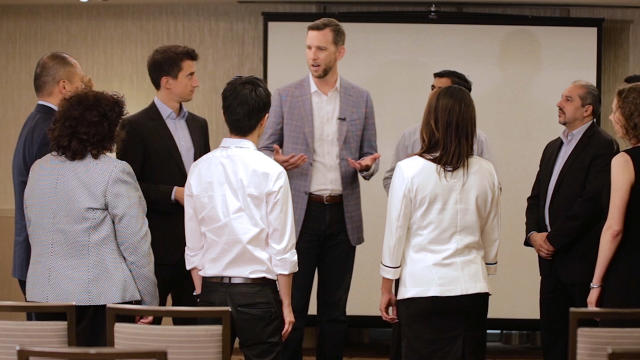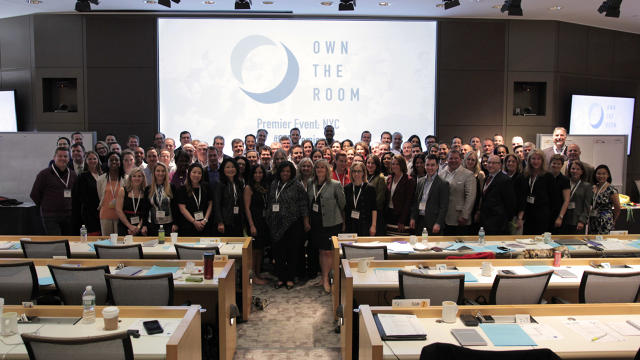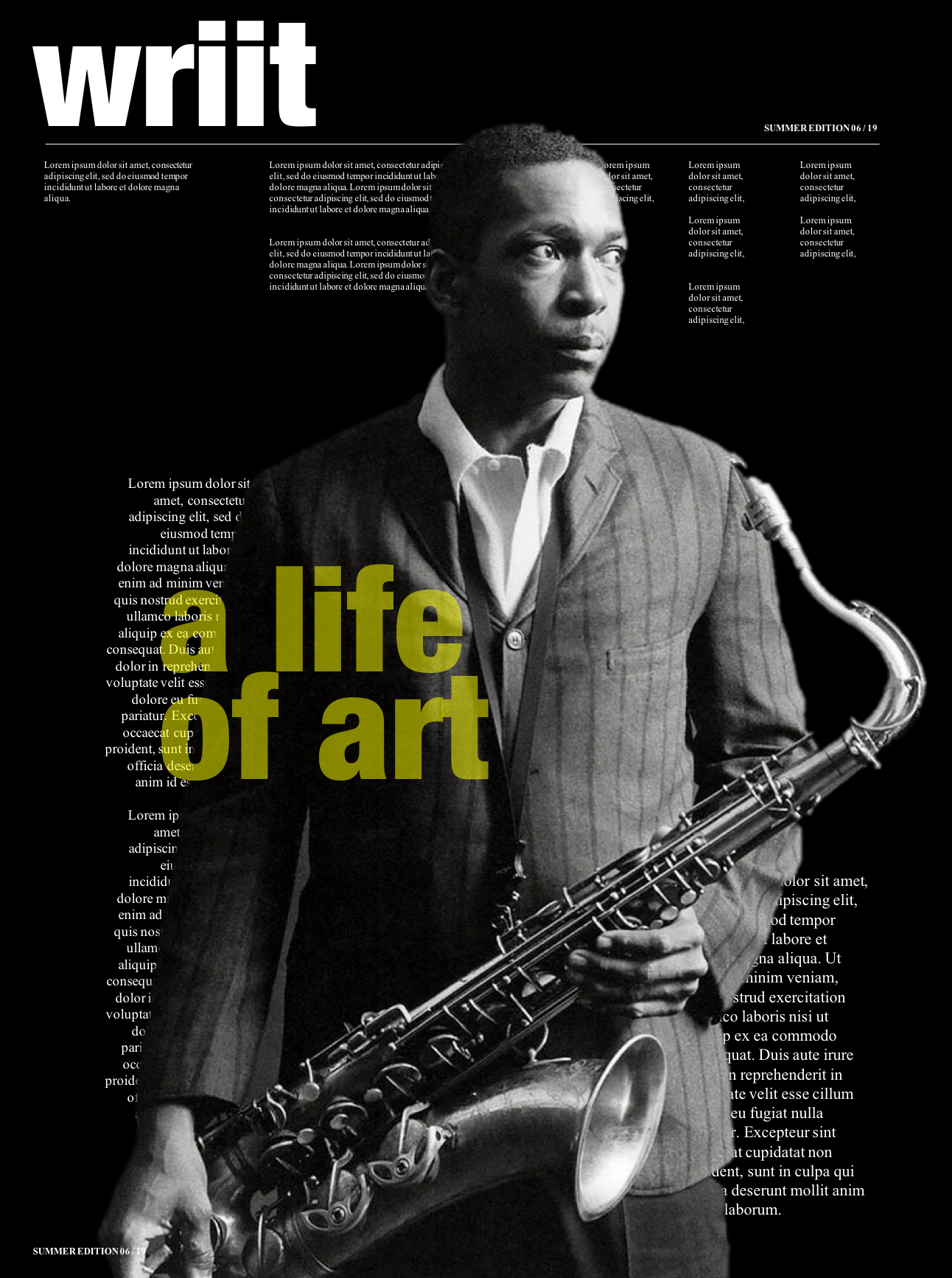The command was simple: Create an intro to any story beginning with the word “imagine.” The leader gave us all a topic to talk about: energy conservation. I had 10 seconds to prepare. After a pause, I theatrically pointed at my head and said, “Imagine.” I then tried to fill in the blanks, talking about a future where open fields were filled with wind turbines. But my thoughts became jumbled and terror filled my face. I tried to set the scene of a utopic future where there was neither an energy crisis nor global warming, but the sentences didn’t link, and all that escaped my mouth was gobbledygook.
The woman beside me, my partner for the time being, was kind. “The beginning was good,” said the PR executive, 40. But it was clear I had bombed.
We were attending a two-day conference: me, this woman, and about 90 other people all together in a large auditorium. The event—hosted by the company Own The Room—dubbed itself a retreat where “executives from different industries come to learn to communicate more effectively and have a great time in the process.” The price tag was indeed C-Level at $3,400, but it did boast Sheryl Sandberg’s endorsement.
The room was filled with many people who occupied spots near the top of their org charts. The people attending were separated into about nine different groups. My enclave included a VP from Johnson & Johnson, someone from PepsiCo, and a few CEOs and founders. I surveyed the room and found other groups contained similar rankings. I even spotted the brother of a well-known politician in our midst.
Most of the people I talked to generally had the same goal in mind: They frequently gave presentations—be it to a small group of employees or to hundreds of people—and wanted to improve their performance. Some had issues with engaging people, others just wanted to be more dynamic. One woman sitting beside me—a health care company executive—was filling in for a colleague of hers, but had heard about it from numerous other people. While people were happy to chat about why they were attending, nearly everyone declined to be named, as they were all there on their companies’ dime.

As for me, I’ve always considered myself an okay public speaker. I know how to tell a good joke, and audiences generally react well enough. But I’ve never focused on the exact things that I say, or the way that I relate to an audience. Comparatively, most other people in the room seemed to have led more than a few important meetings. I was probably the least experienced public speaker in that room.
The day was segmented into large and small group activities. The first hour, we just worked on introducing ourselves. We learned the tricks of drawing in an audience. “Tell a story,” the coach told us. Never begin with your name. The very first exercise was learning how to master this seemingly simple task. We were partnered with someone else, and then told to introduce ourselves in an engaging way—without leading with our name.
This led to some intriguing, if not necessarily business appropriate intros. One person, a 40-year-old man who worked for a company that helps people with substance abuse, opened, “I am a recovering alcoholic.” A dark-haired man in his thirties said, “I know more about breasts than you,” and then went on to talk about his lactation-focused business. It’s true, if these people had merely stated their names, I probably wouldn’t be as interested in what they do. I simply opened with, “I like to tell a good story.”
Another key “trick” was learning to hone language. One coach explained that most language spoken day to day is “weak”—that is, the “uhs,” “ums,” “yeahs,” etc. We spent the rest of the day trying to pry these vocal tics from our repertoire. A participant—another corporate VP—and I were asked to deliver an engaging 15-second presentation about where we see ourselves in 10 years. The catch: Every time we uttered those weak, bad words, we had to drink a sip of watered-down Coke (it was a “drinking game,” get it?). I went first and had to drink four times. My partner went second and didn’t drink once. “It’s easier going second,” he conceded.
If you’ve ever been to a session about how to present, these exercises and tricks aren’t necessarily new. Own The Room fits squarely in an industry that’s been around for decades: executive coaching and education. Since boardrooms have been ground zero for presentations, employees have worked to enhance their ability to communicate and engage.
The market is quite big, too. One report from 2014 put the global corporate training market at over $130 billion. And another 2015 report saw that same market growing from 2015-2019 at compound annual growth rate of 8%. Everyone I talked with agreed that they saw this as an opportunity to have a few days off and practice these skills. A few had been to other Own The Room events, and simply liked attending because it gave them the ability to work further on honing the craft.
Of course, there have always been people claiming to have the secrets for good group communication, much like business and personal gurus have long claimed to know the “secrets to success.” The cult of entrepreneurship bleeds into Own The Room’s pitch. There are zen-like secrets for mastering a good business presentation, as well as allusions that the greatest executives are the most persuasive and masterful of language. Every mini session had one, if not many, catchphrases that were both helpful and grandiose. “Tell a story,” repeated one presenter. Another coach’s mantra: “Get over yourself.” A session I attended was simply titled, “Connect First.”

With all of these tools, the ultimate goal is for the participants to be able to have a more commanding presence over an audience. The event culminated with each person giving their own two-minute presentation about whatever they choose. Hopefully they would take these tools back home and lead a great meeting, or deliver a perfect pitch, or give the best presentation.
But as Own The Room CEO Jack Harvey told me later on in the day, the executive coaching space is fractured. There are dozens of individual coaches out there—each with their own specialties—and a few companies offering events like this. But the offerings are still all over the place and there’s no one leader.
One company, Reboot, is similarly positioned. It calls itself a coaching company that helps “entrepreneurs and their teams deal with the internal ups and downs of entrepreneurship.” Like Own The Room, it hosts bootcamps and coaching sessions. But Reboot is tailored more for the startup environment and the growing and learning entrepreneur. And there are big names—especially in Silicon Valley—known as guru coaches including Bill Campbell (who worked at both Apple and Intuit and has reportedly coached numerous tech giants) and Ron Conway (a well-known angel investor who’s been known to pitch in for the companies in his network).

Own The Room appears to want to court both entrepreneurial upstarts, as well as be used in Fortune 500 boardrooms around the world. According to Harvey, in the last year his program has been used by about 100 companies (including Facebook and LinkedIn) in 27 countries. He adds that bigger corporations with upwards of 300,000 employees have begun to bring the Own The Room program into their offices.
Harvey sees this as proof that there’s a market opening for a big name in the executive coaching industry. More importantly, he doesn’t consider Own The Room a one-off coaching session provider. Instead, it’s a “communication methodology.” Like the coaches under him, Harvey uses big ideas to underscore what his company can do. It’s not just showing people how to present in public, he assured me, it’s something more: “How do they release their full potential?”
This is the kind of language you hear at both an executive training session and a new agey self-realization retreat. And to the untrained eye, the two are quite similar. Harvey—along with all the other coaches—would, of course, balk at this comparison. He reminds me that no Own The Room employee ever lectures while giving a coaching session. Also, the presenters never talk about themselves. “You will not find a bombast,” he says. And he is right—the sessions I attended were neither self-reflexive nor philosophy laden. And they were very interactive.

The grandiose sense is perhaps just the name of the game at these events. If you’re paying the hefty price, then you might as well feel like you’re in a special club of highfalutin gesticulations and potential professional realization. And everyone I talked with seemed okay with this. One HR executive saw a dual sense at the event. While the coaches seemed like they were teaching life tips, she didn’t quite get that. “I feel like I’m acting,” she said. “I want to feel more authentic.” The coach assured her that would come with practice.
In the end, I did learn some good public speaking tips that I’ll likely use in the future. But I’m probably still not qualified to stand in for your next executive conference. My full potential has yet to be realized.
